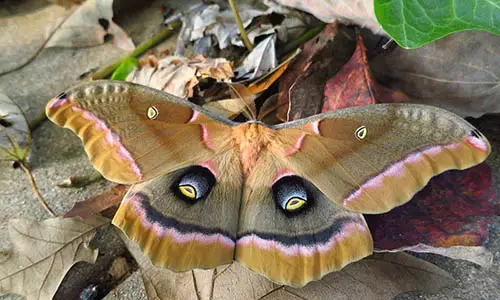Moths (Scientific name: Gynnidomorpha Alisman) are herbivores animals, belonging to class Insecta, and closely related to butterflies. They are different from butterflies only in terms of taxonomy. There are about 200,000 species of moths found globally. Moths possess feather like antennae with no club at the end. Moths have thick hairy bodies and the color of their wings pertain to earth tone (browns, tans, warm grays and greens). The proboscis or tongue of moths is very long and used to draw juices or nectar from plants and flowers.
The various body parts of moths, namely, antennae, palps, legs are dotted with sense receptors that are used to smell. These sense receptors help in searching for food which is flower nectar, usually and for finding mates. Moths are very attractive insects and here.
we have some dazzling facts about them worth to know:
- Moths’ bodies are composed beautifully having bright colors and dazzling patterns. Some moths do not have mouths. The Luna, a beautiful moth, cannot eat anything for the lack of mouth and it lives only for about one week for the single aim of mating.
- Moths have a great love for beer. If we mix a paste of beer, brown sugar and banana and stick it to some tree’s trunk, we shall observe a throng of moths that get attracted to it in the evening.
- Moths are great imitators. They can imitate other animals so as to escape an attack by a predator. The Polyphemus moth possesses bold eyespots which it uses to confuse the predators who perceive it as their food. The hornet moth proves to be harmless, in spite of its hornet-shaped body. The wood nymph is a beautiful moth which just looks like a bird poop.
- Moths have a nocturnal lifestyle, so they get attracted to lights. They are also believed to fly in a straight line as they use the moon and stars for navigation.
- The Hummingbird moth is known to have a tongue even larger than its own body. Darwin’s Madagascan Hawk moth possesses a tongue nearly 13 inches long to enable it to feed on deep throated orchids growing in the region. There are other moths which have shorter tongues.
- The coloration, on the body of moths, including various lines and spots, confuses a predator trying to aim in at them. So, the moth’s colorful body helps it to escape an attack by a predator.
- Moths vary in size greatly. There are some moths which are quite large and others which are very small. The Atlas moth is the largest moth and has a wingspan of 10 inches. It has a surface of 62 square inches. On the other hand, a very small moth, measuring only 1 mm in length and a wingspan of 2 to 2.5 mm, was also discovered in the Demographic Republic of the Congo in year 2012.
- Moths act as important pollinators. They pick-up pollens from any flower they land on in search of food. This makes them major agricultural pests. The flowers, so pollinated by moths, tend to emit out fragrance and be white like the yucca plant. Some moths are nocturnal and some pollinate during day time, like the Hummingbird.
- Some male moths are able to smell female moths even at a distance of more than 7 miles. They, generally, do not have noses but, are, still good sniffers. Their antennae, having hair like scent receptors, help them to identify a single molecule of the sex hormone (Pheromone) of a female moth 7 miles away from them.
- Moths are found in abundance which makes them a huge source of food for many animals. Tiger moths are able to defend themselves against their predators, bats, by producing ultrasonic clicking sounds which makes hard for the bats to find them.
- The cloth moths like to eat things such as wool, fur and other animal products. They can digest keratin which is a protein found in their foods.
- Moths have compound eyes and simple eyes composed of many hexagonal lens which takes into account light from each part of their area of view. They have a very different vision from humans and they can even see ultraviolet rays which are invisible to human eye. Most of the caterpillars have simple eyes and they can hardly see at all.
- Moths, being nocturnal, lack the radiant energy of the sun for heating up their flight muscles. So, they tend to do so by vibrating their wings.
- Moths have the Johnston’s organ at the base of their antennae responsible for maintaining their orientation and balance when they are flying.
- The fastest flying moth in the world, the Sphinx Hawk, can reach a speed of over 30 miles per hour.
- The average life-span of moths is 40 days. They can even have a two year life cycle in colder climates.











Leave a Reply